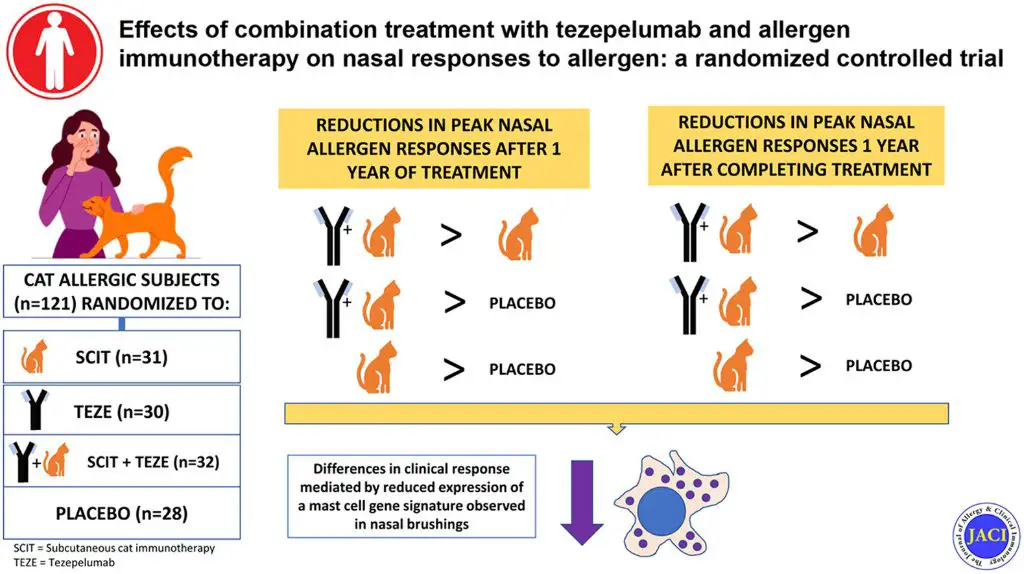What Are Cat Allergies?
Cat allergies are caused by an immune system reaction to certain proteins found in cat dander (skin flakes), saliva, or urine (1). When exposed to these allergens, the immune system mistakenly identifies them as harmful and releases antibodies called immunoglobulin E (IgE) to attack them. The release of IgE triggers the release of chemicals like histamine that lead to common allergy symptoms.
According to WebMD, the most common symptoms of cat allergies include (1):
- Sneezing
- Itchy, watery eyes
- Congestion
- Coughing
- Wheezing
- Hives or skin rash
In severe cases, cat allergies can trigger asthma attacks. Reactions typically occur within minutes after exposure and can last for hours. With continued exposure, symptoms may worsen over time.
Who Gets Cat Allergies?
Studies estimate that around 10-20% of the population worldwide has cat allergies (Sparkes, 2022). These allergies tend to be more common among people who suffer from asthma and other allergic conditions. Genetic factors also play an important role in determining who develops cat allergies. People with a family history of allergies have a higher risk of reacting to cats.

According to the Asthma and Allergy Foundation of America (AAFA), sensitization rates to cats are generally around 5-20% (Allergic to Your Pet? Learn About Dog and Cat Allergies). Certain gene clusters like cytokine genes have been associated with cat allergies, indicating a hereditary component. Environmental factors can also influence the development and severity of cat allergies.
In summary, cat allergies tend to run in families and are more prevalent among asthma sufferers. Genetics and environmental exposures interact to determine an individual’s level of sensitivity and reaction to cats (Sparkes, 2022).
Can Cat Allergies Be Fatal?
It is extremely rare for cat allergies alone to directly cause death. However, some individuals with severe cat allergies can experience anaphylaxis, a potentially life-threatening allergic reaction. Anaphylaxis causes symptoms like difficulty breathing, throat swelling, and low blood pressure, and can very rarely lead to death if untreated (source).
While anaphylaxis is possible with cat allergies, it is very uncommon. More often, the concern around fatalities stems from individuals who have asthma in addition to cat allergies. For people with asthma, exposure to allergens like cat dander can trigger severe asthma attacks, which can potentially be fatal in rare cases (source).
Overall, death caused directly and solely by cat allergies is extremely rare. However, anaphylaxis and asthma complications are risks to be aware of for sensitive individuals. With proper allergy management and treatment, even those with severe allergies can often safely live with cats.
Treating Mild Cat Allergies
For mild cat allergies, the most effective treatment is to avoid contact with cats as much as possible. However, some simple steps can help reduce allergy symptoms when exposure can’t be completely prevented.
One of the easiest ways to reduce exposure is to wash your hands immediately after touching a cat. Handwashing removes dander and saliva that can trigger a reaction. Warm water and soap are ideal for washing away allergens[1].

Using HEPA air filters can also help by capturing cat allergens in home HVAC systems and room air purifiers. HEPA filters are proven to remove over 99% of pet dander floating in the air[2].
Finally, over-the-counter antihistamines like cetirizine, loratadine, or fexofenadine can alleviate allergy symptoms when exposure can’t be avoided. Antihistamines block histamine receptors to minimize sneezing, itchy eyes, and runny nose[3].
Treating Severe Cat Allergies
For people with severe cat allergies that significantly impact their quality of life, stronger treatment options may be necessary. Some options include:
Allergy Shots – Allergy shots, also known as allergen immunotherapy, can help desensitize the immune system to cat allergens over time. According to Healthline, allergy shots involve receiving regular injections of small doses of cat allergens in order to build up immunity.
Newer Allergy Medications – Newer prescription allergy medications like antihistamines and leukotriene inhibitors may provide more effective symptom relief than over-the-counter options, according to WebMD.
Keeping Home Very Clean – Diligently cleaning the home and using HEPA air filters can help reduce allergen levels. This involves washing bedding weekly, dusting and vacuuming frequently, and keeping the cat out of bedrooms, according to The Ohio State University Veterinary Medical Center.
Rehoming Cat – In severe cases where allergy treatments are ineffective, rehoming the cat may be necessary to protect the person’s health.
Allergy Testing
Allergy testing is crucial for identifying the specific allergen that triggers cat allergies. This allows targeted treatment and management of symptoms. There are two main methods for allergy testing:
Skin prick tests involve pricking the skin with small amounts of suspected allergens like cat dander or saliva. A positive reaction results in a small, itchy red bump. Skin prick tests are affordable and provide quick results, but have a small risk of triggering anaphylaxis in highly sensitive individuals.[1]

Blood tests measure immunoglobulin E (IgE) antibodies to different allergens. The RAST blood test can detect IgE antibodies specific to cat proteins. While less risky than skin prick testing, blood tests are more expensive and results take longer.[2]
Allergy testing will pinpoint whether a person is allergic to cat dander, saliva, or urine. This helps determine the best ways to limit allergen exposure. For example, keeping cats out of bedrooms and vacuuming frequently reduces airborne dander. Knowing the specific allergen is key for appropriate treatment.
Cross-Reactivity
People who are allergic to cats may also react to other pets due to a phenomenon known as cross-reactivity. This occurs when the immune system identifies similar proteins in different allergens as threats. According to a case study published in Allergologia et Immunopathologia, a patient with a severe cat allergy experienced anaphylactic shock after contact with lions, tigers, and other big cats at a zoo.
Cat dander contains a major allergen called Fel d 1 that is also present in dogs, horses, rabbits and other mammals. Exposure to these animals can trigger allergic reactions in people sensitive to cat dander, even if they have never been around cats before. According to ThermoFisher Scientific, cross-reactivity is common between cat, dog and horse dander due to similarity of proteins.
In addition to animal dander, pollen is another common source of cross-reactivity in cat-allergic individuals. This is because the Fel d 1 allergen in cat dander shares structural similarity with certain pollen proteins. As a result, people with cat allergies may experience seasonal allergy symptoms or reactions to certain foods like apples, celery or hazelnuts that contain proteins resembling Fel d 1.
Preventing Reactions
There are several steps that can help prevent allergic reactions to cats:
Washing hands and clothes after interacting with cats is important to remove any dander that may trigger a reaction. Showering and changing clothes after prolonged exposure can also help.
Keeping cats out of bedrooms and limiting them to a few rooms can reduce exposure during sleep. Use high-quality HEPA air filters in bedrooms and common areas to filter out allergens.
Medications like antihistamines and nasal corticosteroid sprays can be taken before interactions with cats to block allergy symptoms. Immunotherapy shots can help desensitize the immune system over time.
While not foolproof, being vigilant about hygiene, controlling cat access, and proper medication use can greatly reduce allergic reactions in those sensitive to cats. See an allergist if preventative measures are still not sufficient.
Allergy Shots
Allergy shots, also known as immunotherapy, can greatly reduce cat allergy symptoms through a process called desensitization. This involves injecting small and gradually increasing doses of cat allergens in order to retrain the immune system to stop overreacting to the allergens.
Allergy shots work by exposing the body to tiny amounts of the allergen, starting with extremely small doses. Over time, the doses are slowly increased in a carefully controlled setting under medical supervision. This allows the immune system to get used to the allergens so it no longer sees them as a threat.

While allergy shots can take several months to start working, they have been shown to significantly reduce allergy symptoms and the need for medication in many people. According to research from the National Institutes of Health, allergy shots can provide longer-lasting relief compared to other allergy treatments.[1]
The downside is that allergy shots require regular injections, usually 1-2 times per week followed by monthly maintenance injections. This long-term commitment is necessary to get the full benefits of immunotherapy. However, for those with severe cat allergies, allergy shots may provide the best chance for managing symptoms and improving quality of life.
Long-Term Management
For those with severe cat allergies, long-term management is crucial to control symptoms and prevent serious reactions. This involves a combination of avoidance techniques and medications.
It’s important to keep cats out of bedrooms and restrict them to certain areas of the home that can be easily cleaned. HEPA air purifiers can help remove allergens from the air. Vacuuming carpets and washing bedding frequently also reduces allergens (1).
Medications like antihistamines and nasal corticosteroid sprays can be taken daily to control allergy symptoms. For people with asthma, it’s critical to keep the condition well-controlled with inhalers as recommended by a doctor (2).
Irritants like smoke and strong scents should be avoided, as these can worsen allergies. Keeping the home clean and free of dust, mold, and other allergens can further reduce reactions (3).
